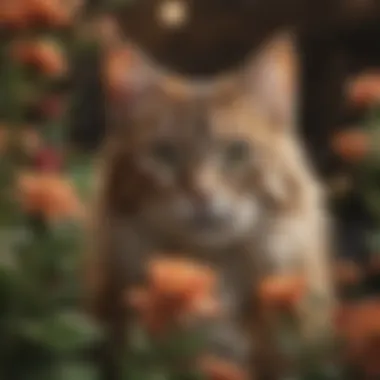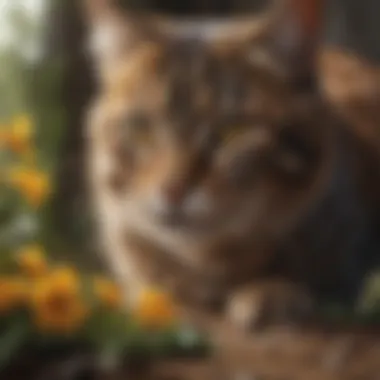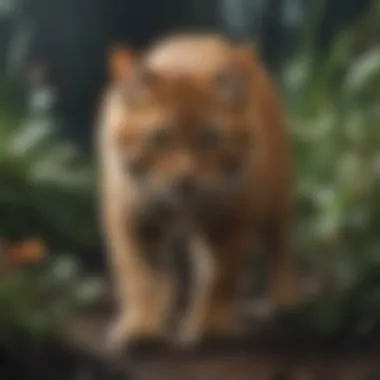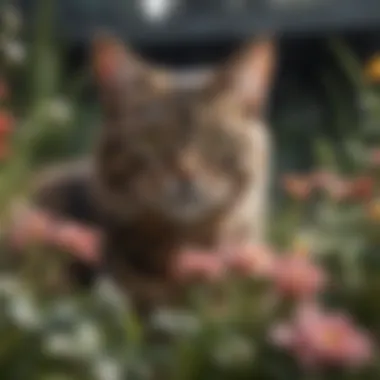Unveiling the Hazards: Toxic Flowers and Their Risks to Cats


Animal Species Profile
When it comes to understanding the dangers that toxic flowers pose to cats, it is crucial to delve into the intricate world of feline physiology and behavior. Cats, known scientifically as Felis catus, are captivating creatures with a long history of domestication alongside humans. In appearance, cats exhibit a wide array of breeds, each with its distinct physical characteristics such as fur length, color patterns, and eye shapes. From the regal Siamese to the fluffy Persian, the diversity among cat breeds is noteworthy. Cats are carnivorous mammals with a keen sense of agility and grace, traits that are crucial for their survival in the wild.
Known for their independent nature, cats have a notable territorial instinct, often marking their environment with scent. The natural habitat of cats varies significantly, encompassing diverse landscapes ranging from urban cityscapes to rural farmlands. Originally desert-dwelling animals, domestic cats have adapted to thrive in human habitats, showcasing their remarkable ability to coexist with humans while maintaining their wild instincts.
It's fascinating to observe the social dynamics within cat colonies, highlighting intricate hierarchies and communication methods. From friendly purring to intense hissing, cats communicate using a wide range of vocalizations and body language cues. Understanding these behavioral aspects is essential in deciphering their reactions to different stimuli, including exposure to toxic flowers.
Introduction
Flowers, usually considered delicate and beautiful, can pose significant dangers to our feline companions if not approached with caution. This article on the dangers of toxic flowers to cats provides a comprehensive insight into the toxicity levels and repercussions associated with felines being exposed to harmful flowers. By delving into both common and lesser-known toxic flowers, cat owners will be equipped with the necessary knowledge to ensure the safety and well-being of their beloved pets.
Understanding Cat Toxicity
When it comes to understanding cat toxicity, there are two crucial aspects to consider: the overview of how poisonous plants impact cats and the common symptoms that arise when cats are exposed to toxic flowers. These components play a pivotal role in the overall topic by shedding light on the harmful effects flowers can have on feline health. The overview of poisonous plants' impact on cats provides valuable insights into the mechanisms through which flowers can harm our feline friends. On the other hand, understanding the common symptoms of flower toxicity in cats is essential for early detection and proper intervention.
Overview of Poisonous Plants' Impact on Cats
Exploring how poisonous plants impact cats allows us to grasp the severity of the issue. By highlighting the specific plants that are harmful to cats and detailing their effects, cat owners can better protect their pets from potential dangers. Understanding this aspect is beneficial as it provides a detailed account of the various floral threats that exist for cats.
Common Symptoms of Flower Toxicity in Cats
Recognizing the common symptoms associated with flower toxicity in cats is crucial for prompt action. By familiarizing ourselves with these symptoms, such as vomiting, lethargy, and lack of appetite, we can quickly identify when our feline companions are in distress. Knowing these key characteristics is essential as it enables us to address the situation swiftly, potentially saving our cats from further harm.
Why Flowers Can Be Harmful to Cats
Flowers can be harmful to cats due to the presence of specific chemical compounds that are toxic to felines and their heightened sensitivity to certain floral substances. Understanding why flowers pose a risk to our cats is essential in creating a safe environment for them. By delving into the chemical compounds in flowers that are harmful to cats and feline sensitivity to these substances, cat owners can take proactive measures to prevent accidental ingestion.


Chemical Compounds in Flowers Toxic to Cats
Identifying the chemical compounds in flowers that are toxic to cats is crucial in mitigating risks. By being aware of these harmful substances, such as alkaloids and glycosides, cat owners can steer clear of plants containing them. This knowledge is advantageous as it empowers cat owners to make informed decisions when selecting plants for their homes.
Feline Sensitivity to Certain Floral Substances
Understanding feline sensitivity to certain floral substances sheds light on why some flowers can have adverse effects on cats. Cats' heightened sensitivity to certain compounds like lilies and daffodils underscores the need for vigilance when choosing plants in a cat-friendly environment. Recognizing this unique feature is essential as it enhances our awareness of the potential dangers posed by seemingly harmless flowers.
Signs of Flower Toxicity in Cats
Signs of flower toxicity in cats manifest through both physical and behavioral indicators of poisoning. Recognizing these signs and taking immediate actions upon suspecting flower ingestion can make a critical difference in saving a cat's life. Understanding these indicators is imperative for cat owners to act swiftly and effectively in times of crisis.
Physical and Behavioral Indicators of Poisoning
Physical and behavioral indicators of poisoning, such as drooling, difficulty breathing, and seizures, signal a cat's distress. By being attentive to these signs, cat owners can promptly seek veterinary assistance and provide the necessary care. Acknowledging the key characteristic of these indicators is vital as it enables quick identification of potential flower toxicity in cats.
Immediate Actions to Take When Suspecting Flower Ingestion
When suspecting flower ingestion, immediate actions must be taken to mitigate the effects on the cat's health. Inducing vomiting (under veterinary guidance) and contacting a veterinarian are crucial steps in ensuring the cat receives timely treatment. Understanding and promptly executing these actions are advantageous as they can significantly improve the cat's prognosis.
Popular Toxic Flowers for Cats
Several flowers, such as lilies, daffodils, and tulips, are notorious for their toxicity to cats. Understanding the specific dangers posed by these popular toxic flowers is essential for avoiding potential harm to feline companions. By delving into the characteristics of these flowers, cat owners can enhance their knowledge and safeguard their pets effectively.
Lilies: Deadly Beauties for Felines
Lilies, though visually appealing, can be deadly to felines if ingested. Recognizing the toxicity of lilies and the severe consequences they can have on cats is paramount for cat owners. Understanding the key characteristics of lilies' toxicity is crucial as it underscores the importance of keeping these flowers far from the reach of curious cats.
Daffodils: A Bright Danger Lurking


Daffodils, with their vibrant blooms, pose a hidden danger to cats due to the toxins present in various parts of the plant. Being aware of the risks associated with daffodils and their effects on feline health is essential for responsible pet ownership. Acknowledging the unique feature of daffodils' toxicity is vital as it allows cat owners to implement preventive measures effectively.
Tulips: Lovely but Lethal to Cats
Tulips, known for their beauty, can be lethal to cats when ingested. Understanding the dangers tulips pose to felines and the symptoms accompanying their toxicity is crucial for cat owners. Recognizing the key characteristic of tulips being harmful to cats is essential as it highlights the importance of exercising caution when having these flowers around feline companions.
Lesser-Known Toxic Flowers
In this detailed exploration of lesser-known toxic flowers, we shed light on a crucial aspect often overlooked in discussions on feline safety. While popular toxic blooms like lilies and daffodils receive significant attention, lesser-known varieties such as azaleas, sago palms, and oleanders hide potential dangers that can pose serious threats to our feline companions. Understanding these hidden perils is essential for any cat owner striving to create a safe environment for their beloved pets. By delving into the hazards associated with these lesser-known toxic flowers, we aim to provide a holistic perspective on the potential risks lurking in unsuspecting corners of our homes and gardens.
Azaleas: The Silent Threat
Toxic Components Impacting Feline Health
Unveiling the insidious dangers of azaleas, we focus on the specific toxic components that jeopardize feline well-being. The presence of grayanotoxins in azaleas stands out as a primary concern, causing severe health issues in cats upon ingestion. These compounds disrupt vital bodily functions, leading to symptoms ranging from gastrointestinal distress to more severe neurological complications. The unique and potent nature of these toxic components underscores the critical need for awareness and preventive measures to safeguard our feline friends. Despite their charming exterior, azaleas harbor a silent threat that pet owners must recognize and address proactively.
Sago Palm: Deceptive Danger in Floral Form
Lethal Effects on Cats' Vital Systems
Exploring the deceptive allure of sago palms, we delve into the lethal effects they exert on cats' vital systems. Consumption of any part of the sago palm can result in liver failure, leading to severe consequences for feline health. The cycasin toxin present in sago palms poses a significant threat, causing rapid deterioration in cats' well-being. Recognizing the severity of these effects is paramount in mitigating the risks associated with these seemingly innocent ornamental plants. Despite their aesthetic appeal, sago palms represent a deceptive danger that pet owners must acknowledge to ensure the safety of their beloved pets.
Oleander: A Fatal Beauty for Felines
Cardiac Risks Posed by Oleander Consumption
Diving into the fatal beauty of oleanders, we highlight the cardiac risks they pose to felines upon consumption. The presence of cardiac glycosides in oleanders can have devastating effects on cats' heart function, potentially leading to life-threatening arrhythmias. Understanding the implications of oleander ingestion is vital for prompt intervention and treatment in cases of accidental exposure. Despite their visually striking appearance, oleanders harbor a fatal beauty that conceals significant dangers for our feline companions. Recognizing the cardiac risks associated with oleanders is crucial for responsible pet ownership and proactive prevention of floral toxicity.


Preventive Measures and Actions
Preventive measures and actions play a crucial role in safeguarding our beloved feline companions from the dangers of toxic flowers. By implementing strategic protocols and safety measures, cat owners can mitigate the risks associated with flower toxicity. These actions not only protect cats from potential harm but also promote a safe and secure environment within our homes. It is imperative to understand the significance of preventive measures and actions in ensuring the well-being of our furry friends.
Creating a Safe Environment for Cats
To create a safe environment for cats, a combination of indoor and outdoor safety tips is essential. Indoor safety measures include keeping toxic flowers out of reach, opting for pet-friendly plant alternatives, and supervising cats closely. Outdoor safety involves being vigilant of the surrounding flora, ensuring the absence of harmful plants in outdoor spaces where cats roam freely. These tips contribute significantly to minimizing the risk of flower ingestion and exposure to toxic substances.
- Tips for Indoor and Outdoor Safety: Secure poisonous flowers in inaccessible areas, choose non-toxic plant varieties, and provide enriching indoor environments for cats. These safety measures are beneficial for cat owners seeking to cultivate a cat-friendly space and reduce potential hazards associated with toxic flowers.
- Alternative Pet-Safe Plants for Cat-Friendly Homes: Introducing pet-safe plants adds a layer of protection for cats. Opting for plants such as catnip, spider plant, or Boston ferns can enhance the living environment for both cats and their owners. The unique feature of these alternative plants lies in their non-toxic nature, ensuring a safe and enriching atmosphere for feline inhabitants.
Emergency Response Protocol
An emergency response protocol is essential in cases of flower ingestion or suspected poisoning incidents. Swift and decisive actions can be the difference between life and death for our feline companions. By having a clear protocol in place, cat owners can act promptly to address emergencies and seek necessary medical assistance.
- Steps to Follow in Case of Flower Ingestion: Immediate responses such as removing any remaining flower pieces from the cat's mouth, offering water to dilute potential toxins, and monitoring the cat for any adverse reactions are critical steps to follow. These actions can help minimize the impact of flower ingestion on the cat's health.
- Contacting Veterinarian for Immediate Assistance: Promptly contacting a veterinarian in cases of suspected flower poisoning is paramount. Veterinarians can provide guidance over the phone and recommend necessary steps to take before arriving at the clinic. This unique feature ensures that professional help is just a call away, addressing emergencies efficiently.
Educational Campaigns and Awareness
Educational campaigns and awareness initiatives are pivotal in disseminating knowledge on feline flower toxicity to a wider audience. By promoting awareness among cat owners and plant enthusiasts, the risks associated with toxic flowers can be mitigated, fostering a safer environment for cats and other pets.
- Promoting Knowledge on Feline Flower Toxicity: Educating the public about common toxic flowers and their effects on cats increases awareness and helps prevent accidental flower ingestion. This initiative serves as a valuable resource for cat owners, enabling them to make informed decisions regarding plant ownership and pet safety.
- Raising Awareness Among Cat Owners and Plant Enthusiasts: By raising awareness among cat owners and plant enthusiasts, a ripple effect of precautionary measures is set in motion. Increasing understanding and vigilance in the community can lead to a decreased occurrence of flower-related incidents, ultimately promoting the well-being of feline companions and nurturing a sense of responsibility among pet owners.
Conclusion
In the realm of feline safety and well-being, it is imperative to grasp the dangers that toxic flowers pose to cats. This comprehensive guide has shed light on the various levels of toxicity found in different flowers and the severe consequences that may arise from feline exposure to these harmful blooms. By meticulously examining both common and lesser-known toxic flowers, readers have been equipped with invaluable knowledge to safeguard their beloved feline companions from potential hazards.
Final Thoughts on Cat Safety and Floral Hazards
Importance of Diligence in Protecting Cats
Delving into the significance of diligence in safeguarding our feline friends reveals a vital aspect of ensuring cat safety amidst floral dangers. The meticulous care and consistent vigilance required in protecting cats from toxic flowers underscore the meticulous nature of responsible pet ownership. Highlighting this aspect not only fortifies the commitment to safeguarding cat well-being but also emphasizes the necessity of thorough awareness and proactive measures within the feline-loving community. The unique convergence of attentiveness, caution, and swift action encapsulates the essence of diligence in mitigating floral hazards faced by our treasured feline companions, portraying a commitment to their health and safety.
Encouraging Responsible Plant Ownership for Pet Well-Being
Emphasizing the promotion of responsible plant ownership for the welfare of pets contributes significantly to the overarching goal of ensuring feline safety amid floral hazards. By advocating for the selection of non-toxic plants and creating pet-friendly environments, the narrative transcends mere caution towards active protection of our furry friends. The key characteristic of this approach lies in its proactive nature, where pet owners actively seek out pet-safe alternatives to adorn their living spaces. This unique advocacy not only fosters a healthier environment for pets but also educates pet owners, fostering a culture of consciousness and responsibility towards promoting animal well-being within the plant-loving community. The symbiosis between responsible plant ownership and pet well-being underscores a harmonious coexistence that prioritizes the health and happiness of our beloved animal companions.







